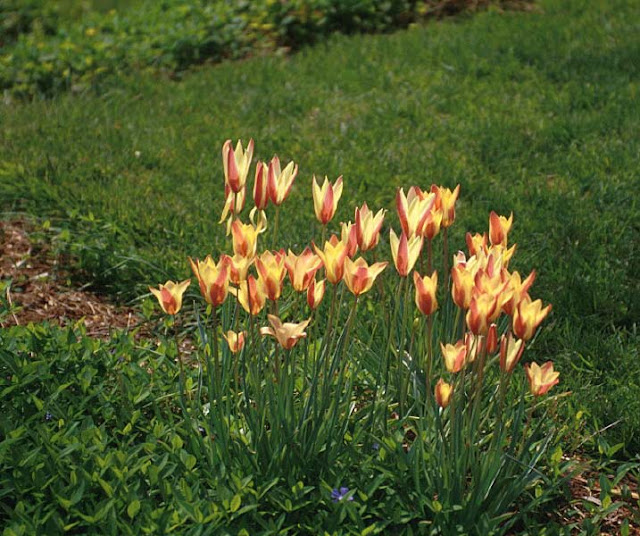Tulipa bakeri 'Lilac Wonder'
Tulip
Type Perennial
Hardy range 6A to 8A
Height 4" to 6" / 10cm to 15cm
Spread 4" to 6" / 10cm to 15cm
Growth rate Average
Form Upright or erect
Exposure Full sun
Persistence Deciduous
Bloom Color Purple
Bloom Time Spring
The flowers are suitable for cut flowers.
Environment
This plant will grow in moist soil.
Suitable soil is well-drained/loamy.
The pH preference is a neutral soil.
Leaf Color Green
Culture Notes
Lifting and replanting of bulbs is recommended every 2-3 years in the fall to prevent crowding. Tulips prefer a moist, but well-drained soil.
Tulipa x 'Early Harvest'
Hybrid Tulip
Type Perennial
Hardy range 3A to 8A
Height 12" to 18" / 30cm to 45cm
Spread 6" to 10" / 15cm to 25cm
Growth rate Average
Form Upright or erect
Exposure Partial shade or partial sun to full sun
Persistence Deciduous
Bloom Color Red
Bloom Time Spring
The flowers are suitable for cut flowers.
Environment
This plant will grow in moist soil.
Suitable soil is well-drained/loamy or sandy.
The pH preference is a neutral soil.
Leaf Color Green
Culture Notes
Most of the hybrids bloom for a few seasons and then need to be divided or removed. Tulips should be planted in the fall in soil that is fertile and well-drained. Deadheading and feeding can promote longevity.
Tulipa clusiana
Lady Tulip
Type Perennial
Hardy range 3A to 8A
Height 9" to 12" / 23cm to 30cm
Spread 6" to 10" / 15cm to 25cm
Growth rate Average
Form Upright or erect
Exposure Partial shade or partial sun to full sun
Bloom Color Red and white
Bloom Time Spring
The flowers are suitable for cut flowers.
Environment
This plant will grow in moist soil.
Suitable soil is well-drained/loamy or sandy.
The pH preference is a neutral soil.
Leaf Color Green
Culture Notes
Lifting and replanting of bulbs is recommended every 2-3 years in the fall to prevent crowding. Dead heading and feeding can promote longevity. T. clusiana yields striking white blossoms with red stripes.
Curcuma alismatifolia
Siam Tulip, Summer Tulip
Type Perennial
Hardy range 8A to 11
Height 18" to 24" / 45cm to 60cm
Growth rate Average
Form Upright or erect
Exposure Partial shade or partial sun to full sun
Bloom Color Pink, red and white
Bloom Time Summer and Fall
The flowers are showy and suitable for cut flowers.
Environment
This plant will grow in dry to moist soil.
Suitable soil is well-drained/loamy, sandy or clay.
The pH preference is an acidic to neutral (less than 6.8 to 7.2) soil.
Leaf Color Green
Culture Notes
Many new white, pink, red and rose cultivars of this plant have been introduced. This low-maintenance, exotic ginger blooms better in bright light. The tips of its snapdragon-looking bracts contain chlorophyll, thereby adding green highlights to the ends. Blooming covers an extended period of time, from June all the way through November. Its vase life is also long, lasting anywhere from 6 to 18 days as a cut flower.
Tulipa x 'Texas Fire'
Hybrid Tulip
Type Perennial
Hardy range 3A to 8A
Height 12" to 30" / 30cm to 75cm
Spread 6" to 10" / 15cm to 25cm
Growth rate Average
Form Upright or erect
Exposure Partial shade or partial sun to full sun
Persistence Deciduous
Bloom Color Purple and red
Bloom Time Spring
The flowers are suitable for cut flowers.
Environment
This plant will grow in moist soil.
Suitable soil is well-drained/loamy or sandy.
The pH preference is a neutral soil.
Leaf Color Green
Culture Notes
Most of the hybrids bloom for a few seasons and then need to be divided or removed. Tulips should be planted in the fall in soil that is fertile and well-drained. Dead heading and feeding can promote longevity.
Tulipa x 'Johann Strauss'
Hybrid Tulip
Type Perennial
Hardy range 3A to 8A
Height 12" to 18" / 30cm to 45cm
Spread 6" to 10" / 15cm to 25cm
Growth rate Average
Form Upright or erect
Exposure Partial shade or partial sun to full sun
Persistence Deciduous
Bloom Color White
Bloom Time Spring
The flowers are suitable for cut flowers.
Environment
This plant will grow in moist soil.
Suitable soil is well-drained/loamy or sandy.
The pH preference is a neutral soil.
Leaf Color Green, purple and variegated
Culture Notes
Most of the hybrids bloom for a few seasons and then need to be divided or removed. Tulips should be planted in the fall in soil that is fertile and well-drained. Deadheading and feeding can promote longevity.









